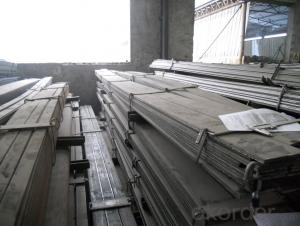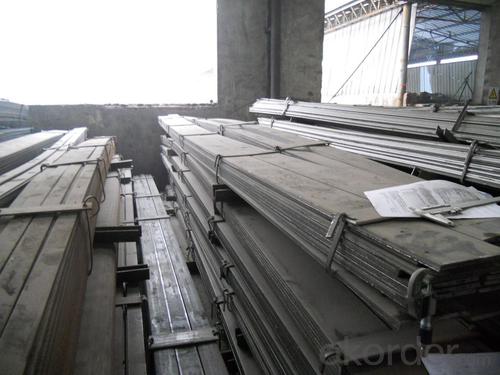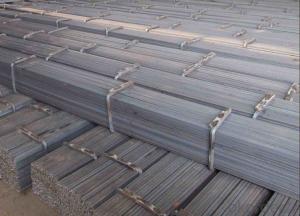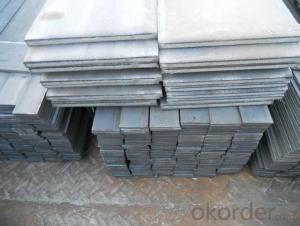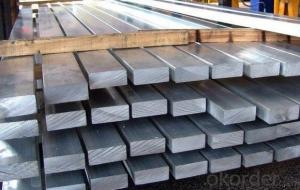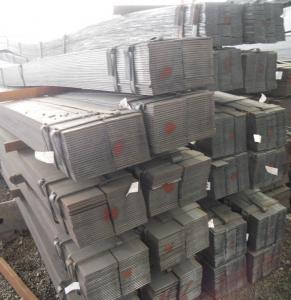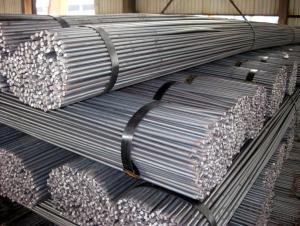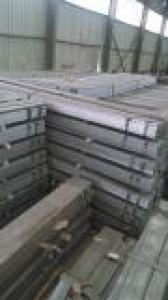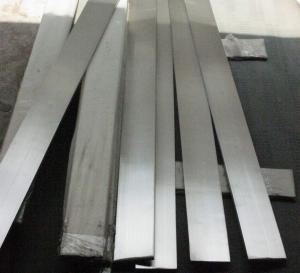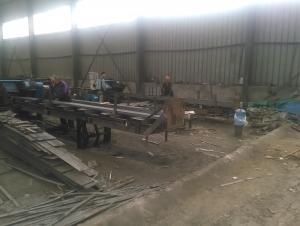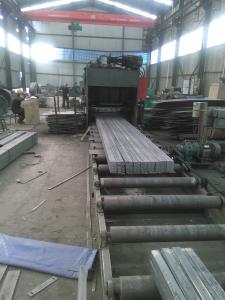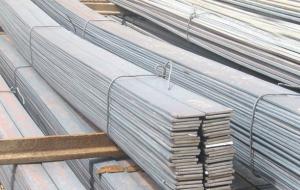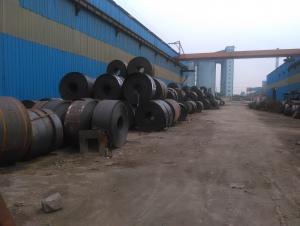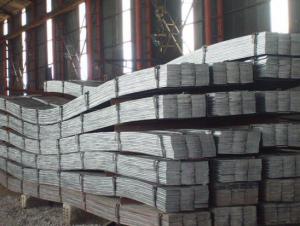Q235 Stainless Steel Flat Bar of Standard: GB
- Loading Port:
- Tianjin
- Payment Terms:
- TT OR LC
- Min Order Qty:
- 25 m.t.
- Supply Capability:
- 1000 m.t./month
OKorder Service Pledge
OKorder Financial Service
You Might Also Like
Product Applications:
Q235 Stainless Steel Flat Bar of Standard: GB are ideal for structural applications and are widely used in the construction of buildings and bridges, and the manufacturing, petrochemical, and transportation industries.
Product Advantages:
OKorder's Q235 Stainless Steel Flat Bar are durable, strong, and resist corrosion.
Main Product Features:
· Premium quality
· Prompt delivery & seaworthy packing (30 days after receiving deposit)
· Corrosion resistance
· Can be recycled and reused
· Mill test certification
· Professional Service
· Competitive pricing
Specification of Q235 Steel Flat Bar
Commodity: Q235 Steel Flat Bar
Standard: GB
Material: Q235
Brand name: FLATSPACE
Origin place: China
Thickness: 3mm-30mm
Width:20mm-200mm
Length: Max 12m
Certification: SGS/BV
Chemical composition of Q235
Alloy No | Grade | Element(%) | ||||
C
| Mn
| S
| P
| Si
| ||
Q235
|
B
|
0.12—0.20 |
0.3—0.7 |
≤0.045 |
≤0.045
|
≤0.3
|
Physical properties of Q235
Alloy No | Grade | Yielding strength point(Mpa) | Tensile strength (Mpa) | Elongation after fracture(%) | ||||||
Thickness (mm) | Thickness (mm) | |||||||||
≤16 | >16--40 | >40--60 | >60--100 | ≤16 | >16--40 | >40--60 | >60--100 | |||
≥ | ≥ | |||||||||
Q235 |
B |
235 |
225 |
215 |
205 |
375--500 |
26 |
25 |
24 |
23 |
Usage/Applications of Q235 Steel Flat Bar
Widely used for construction, Machinery manufacturing, Iron tower steel structure, Shipbuilding; Steel grating, Staircase, Bridge, Viaduct, Railway spare parts, Boilers making etc.
Production Flow of Q235 Steel Flat Bar
The steel flat bar is made through three processes:
1.Feeding the material: Feeding the row material (the steel plate) to Slitting Line.
2.Slitting:The steel plate would be slitted into expected width by lengthways cutter.
3. Leveled and cutting: The plat bar would be ground into level by the grinder and then cut into required length.
Packaging & Delivery of Q235 Steel Flat Bar
Packaging Details: The Steel Flat Bars are packed in bundles and loaded in 20 feet/40 feet container, or shipped by bulk cargo ,also we can do as customer's requirements.
Delivery Details:30~45 days upon the receipt of buyer payment by T.T. or L/C.
FAQ:
Q1: Why buy Materials & Equipment from OKorder.com?
A1: All products offered byOKorder.com are carefully selected from China's most reliable manufacturing enterprises. Through its ISO certifications, OKorder.com adheres to the highest standards and a commitment to supply chain safety and customer satisfaction.
Q2: How do we guarantee the quality of our products?
A2: We have established an advanced quality management system which conducts strict quality tests at every step, from raw materials to the final product. At the same time, we provide extensive follow-up service assurances as required.
Q3: What makes stainless steel stainless?
A3: Stainless steel must contain at least 10.5 % chromium. It is this element that reacts with the oxygen in the air to form a complex chrome-oxide surface layer that is invisible but strong enough to prevent further oxygen from "staining" (rusting) the surface. Higher levels of chromium and the addition of other alloying elements such as nickel and molybdenum enhance this surface layer and improve the corrosion resistance of the stainless material.
Q4: Can stainless steel rust?
A4: Stainless does not "rust" as you think of regular steel rusting with a red oxide on the surface that flakes off. If you see red rust it is probably due to some iron particles that have contaminated the surface of the stainless steel and it is these iron particles that are rusting. Look at the source of the rusting and see if you can remove it from the surface
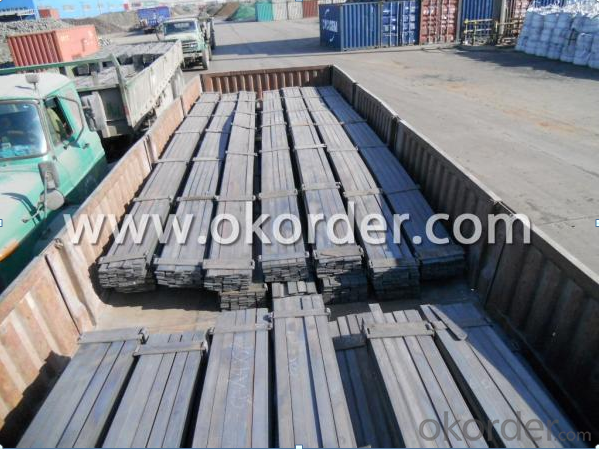
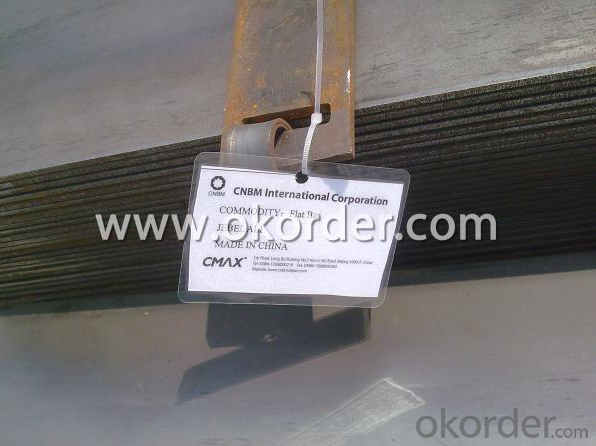
- Q: What is the difference between a steel flat bar and a steel angle bar?
- A steel flat bar and a steel angle bar are two different shapes of steel bars that serve distinct purposes in various applications. A steel flat bar, as the name suggests, is a rectangular-shaped bar with evenly distributed thickness throughout its length. It has a flat surface on the top and bottom, making it ideal for applications that require a level and smooth support or a structural component. Steel flat bars are commonly used in construction, manufacturing, and industrial settings where strength, stability, and load-bearing capacity are crucial. They can be easily welded, machined, or drilled, making them versatile for a wide range of applications. On the other hand, a steel angle bar, also known as an L-shaped bar, has two legs of equal or varying lengths that meet at a 90-degree angle. The legs can have the same or different thicknesses, depending on the desired strength and structural requirements. Steel angle bars are primarily used for structural support, reinforcement, and framing applications. They are commonly used to reinforce corners, joints, or edges of structures such as buildings, bridges, and machinery. The 90-degree angle provides additional strength and stability, making angle bars suitable for heavy-duty applications. In summary, the main difference between a steel flat bar and a steel angle bar lies in their shape and intended use. Steel flat bars have a flat surface throughout their length and are used for various applications that require a level and smooth support or structural component. Steel angle bars, on the other hand, have an L-shaped profile and are primarily used for structural support, reinforcement, and framing applications, especially where additional strength and stability are required.
- Q: How do steel flat bars perform under fatigue loading conditions?
- Due to their high strength and durability, steel flat bars exhibit excellent performance under fatigue loading conditions. Fatigue loading occurs when cyclic loads are repeatedly applied to a material, which can lead to the formation of cracks and eventual failure over time. Steel flat bars are specifically designed to endure such loading conditions by possessing outstanding fatigue resistance. This is primarily achieved through their composition, which includes a significant amount of carbon and other alloying elements like manganese, chromium, and nickel. These elements enhance the material's strength, hardness, and ability to resist deformation and cracking. Furthermore, steel flat bars often undergo heat treatment processes, such as quenching and tempering, to further enhance their fatigue performance. These treatments increase the material's hardness and toughness, making it more resistant to fatigue failure. Another advantage of steel flat bars is their uniform and consistent structure along their entire length. This allows for even distribution of the cyclic loads, preventing stress concentrations and reducing the likelihood of crack initiation and propagation. Moreover, the smooth surface of steel flat bars minimizes stress concentrations and lowers the risk of fatigue failure. The absence of sharp corners or notches eliminates potential stress raisers, ensuring a more uniform distribution of the cyclic loads. In conclusion, steel flat bars are highly suitable for fatigue loading conditions due to their high strength, durability, uniform structure, and smooth surface. These properties enable them to withstand cyclic loads without significant deformation or failure, making them a reliable choice for various applications requiring fatigue resistance.
- Q: Are steel flat bars commonly used in the renewable energy sector?
- Yes, steel flat bars are commonly used in the renewable energy sector. They are often used for various applications such as structural support, framing, and mounting systems for solar panels and wind turbines. Steel flat bars are valued for their strength, durability, and versatility, making them an ideal choice for renewable energy infrastructure projects.
- Q: Are steel flat bars galvanized?
- Not all steel flat bars are galvanized, although galvanization is a process used to apply a protective zinc coating to steel to prevent corrosion. To galvanize the steel, it is immersed in molten zinc, forming a thin layer on the surface that offers excellent corrosion resistance and extends the bar's lifespan. It is crucial to understand that there are steel flat bars that are not galvanized. Depending on the application or customer requirements, some bars may be left untreated or have different types of coatings or finishes. Therefore, it is necessary to verify the product specifications or consult with the manufacturer or supplier to determine if a specific steel flat bar is galvanized or not.
- Q: What are the weight calculations for steel flat bars?
- The weight calculations for steel flat bars depend on the dimensions and density of the specific steel being used. To calculate the weight of a steel flat bar, you would typically multiply the cross-sectional area of the bar by its length and density. The cross-sectional area of a flat bar can be calculated by multiplying its width by its thickness. For example, if a flat bar has a width of 2 inches and a thickness of 0.25 inches, the cross-sectional area would be 0.5 square inches. To determine the weight, you would then multiply the cross-sectional area by the length of the bar and the density of the steel. The density of steel can vary depending on the specific alloy, but a common value is around 7.85 grams per cubic centimeter (or 7850 kilograms per cubic meter). So, if we take the example above and assume a length of 10 feet (or 120 inches), the weight of the steel flat bar can be calculated as follows: Weight = Cross-sectional area x Length x Density Weight = 0.5 square inches x 120 inches x 7850 kilograms per cubic meter Note that the units need to be consistent, so if you're using inches for the dimensions, you may need to convert the density to pounds per cubic inch or ounces per cubic inch. It's important to note that these weight calculations are based on the assumption of a solid steel flat bar. If the bar has any hollow or cut-out sections, the weight calculation would need to be adjusted accordingly. Additionally, different steel alloys may have different densities, so it's always best to consult the specific density for the type of steel you are working with.
- Q: What are the different types of surface patterns available for steel flat bars?
- There are several different types of surface patterns available for steel flat bars, each offering unique characteristics and benefits. Some of the common surface patterns include: 1. Smooth surface: This is the most basic and common surface pattern for steel flat bars. It has a plain, flat surface without any visible patterns or textures. A smooth surface is typically preferred when appearance is not a priority and the focus is on functionality. 2. Serrated surface: Serrated surface patterns feature small grooves or ridges along the length of the steel flat bar. This pattern provides enhanced grip and traction, making it suitable for applications where slip resistance is crucial, such as walkways, ramps, or stair treads. 3. Checker plate pattern: Also known as diamond plate or tread plate pattern, it features a raised diamond-shaped pattern on the surface. This pattern offers excellent slip resistance and is commonly used in industrial settings, loading docks, truck beds, or flooring applications. 4. Hammered pattern: Hammered surface patterns have a textured appearance that resembles the marks left by a hammer. This pattern adds an aesthetic appeal to the steel flat bar and is often used in decorative applications, such as architectural detailing or furniture. 5. Galvanized surface: Galvanization is a process where steel is coated with a layer of zinc to protect it from corrosion. Galvanized steel flat bars have a shiny and smooth surface, providing excellent corrosion resistance and durability. This surface pattern is commonly used in outdoor applications or areas prone to moisture exposure. 6. Painted or powder-coated surface: Steel flat bars can also be painted or powder-coated to provide a specific color or finish. This surface pattern allows for customization and can be used to match the surrounding environment or for aesthetic purposes. It is important to consider the intended use and requirements of the steel flat bar when choosing the appropriate surface pattern. Each pattern offers distinct advantages and selecting the right surface pattern can ensure optimal performance and longevity of the steel flat bar in its intended application.
- Q: Can steel flat bars be used for making renewable energy industry equipment?
- Yes, steel flat bars can be used for making renewable energy industry equipment. Steel is a versatile and widely used material in various industries, including renewable energy. Steel flat bars offer several advantages for the manufacturing of equipment used in the renewable energy sector. Firstly, steel flat bars have excellent strength and durability properties, making them suitable for handling heavy loads and withstanding harsh environmental conditions. Renewable energy equipment, such as wind turbine towers, solar panel frames, and hydroelectric power plant components, often require robust materials to ensure long-lasting performance. Steel flat bars can provide the necessary structural integrity and support needed for such equipment. Secondly, steel flat bars can be easily shaped and fabricated into different forms and sizes, making them suitable for the customization and production of various renewable energy equipment. Whether it's manufacturing brackets, frames, or supports for solar panels or constructing the base for a wind turbine, steel flat bars can be cut, bent, and welded into the desired shape, allowing for flexibility in design and construction. Additionally, steel flat bars offer good corrosion resistance, which is crucial for renewable energy equipment that is often exposed to moisture, saltwater, and other corrosive elements. This corrosion resistance ensures the longevity and reliability of the equipment, reducing maintenance and replacement costs. Furthermore, steel is a sustainable and recyclable material, aligning well with the principles of renewable energy. Steel flat bars can be recycled and reused, reducing the environmental impact associated with manufacturing and disposal. In conclusion, steel flat bars are suitable for making renewable energy industry equipment due to their strength, durability, versatility, and corrosion resistance. With the ability to be fabricated into various forms and shapes, steel flat bars can fulfill the specific requirements of different renewable energy applications.
- Q: Where can I buy steel flat bars?
- You can buy steel flat bars at various locations. Some options include hardware stores, metal supply companies, and online retailers. It is recommended to check your local hardware stores first, as they may carry a selection of steel flat bars in different sizes. Metal supply companies typically have a wider range of options and can provide custom cutting services. Additionally, online retailers such as Amazon and specialty metal suppliers often offer a convenient way to purchase steel flat bars, with the added advantage of a wider selection and competitive pricing.
- Q: What are the common defects found in steel flat bars?
- Common defects found in steel flat bars include surface imperfections such as dents, scratches, or rust, as well as dimensional deviations like warping, bowing, or uneven thickness. Other defects can include cracks, laminations, or inclusions, which may affect the structural integrity of the bar.
- Q: What are the different types of steel flat bar profiles?
- There are several different types of steel flat bar profiles available, each designed for specific applications and requirements. Some common types include: 1. Mild Steel Flat Bar: This is the most commonly used type of steel flat bar, known for its versatility and affordability. It is often used in construction, manufacturing, and general fabrication projects. 2. Stainless Steel Flat Bar: Stainless steel flat bars are corrosion-resistant and have high strength. They are commonly used in industries such as food processing, chemical, and marine applications where resistance to rust and corrosion is crucial. 3. Alloy Steel Flat Bar: Alloy steel flat bars are made by adding various elements such as chromium, nickel, or molybdenum to enhance their strength, hardness, and durability. They are commonly used in applications where high strength and resistance to wear and tear are required. 4. Tool Steel Flat Bar: Tool steel flat bars are specifically designed for use in cutting tools, mold-making, and other tooling applications. They possess high hardness, wear resistance, and toughness, making them suitable for machining and shaping operations. 5. Carbon Steel Flat Bar: Carbon steel flat bars contain primarily carbon as the main alloying element. They are known for their high tensile strength, excellent weldability, and affordability. Carbon steel flat bars find applications in structural components, machinery parts, and general fabrication. Each of these flat bar profiles has its own unique properties and application-specific advantages. The choice of the right type depends on factors such as the intended use, environmental conditions, and required mechanical properties.
Send your message to us
Q235 Stainless Steel Flat Bar of Standard: GB
- Loading Port:
- Tianjin
- Payment Terms:
- TT OR LC
- Min Order Qty:
- 25 m.t.
- Supply Capability:
- 1000 m.t./month
OKorder Service Pledge
OKorder Financial Service
Similar products
Hot products
Hot Searches
Related keywords
